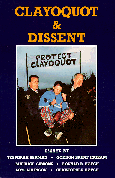
Volume 1 Number 12
September 1, 1995

|
Clayoquot and Dissent.
Essays by Tzeporah Berman, et al.
Vancouver: Ronsdale Press, 1994. 219pp, paper.
ISBN 0-921-870-29-9.
Grades 10 - 13 / Ages 14 - Adult.
Review by Adele Case.
|
excerpt:
Canadian scientists are now addressing the problems of clearcutting
head on. Environment Canada's 1995 report on ``Biodiversity in British
Columbia" states unequivocally that clearcutting causes a ``loss in
biodiversity" and warns that this may have ``economic and social, as well
as ecological repercussions." The Federal government scientists go on to
say that ``Modern methods of partial cutting can be selected and designed
to maintain the structural attributes of old-growth forest, wildlife
habitat, or other non-timber values. However . . . about 90% of the
harvested forests . . . are clear-cut."
The Clayoquot Sound Science Panel has already recommended a shift to
``ecosystem management," the buzzword of the recent American
developments, as well as an avoidance of the practice of clearcutting.
Clayoquot and Dissent is a collection of essays and background
information about past, present, and possible future logging
practices followed in Clayoquot Sound and many other West-Coast logging
sites. The book chronicles issues that had been simmering for years
before boiling over in the protests of 1992 -- issues that concerned not
only environmentalists, citizens, and educators, but also a number of
tribal communities on the ocean side of Vancouver Island.

Many West-Coast ``sounds" (inlet-like arms of the sea) are
inaccessible by road, and contain a complex patchwork of remote islands,
which in the past were carelessly logged using clear-cut methods. With a
clear-cut, the marketable logs are removed en masse, and brush, slash, or
unmarketable small trees are left on the steep hillsides to dry, allowing
the winter and spring rains to wash away the thin topsoil. Little thought
was given to the effect of clear-cutting on spawning streams for fish, or
to the preservation of rare trees, plants, birds, or small animals.
Clayoquot and Dissent carefully lists the attempts of activists and
others to change these practices between 1979 and 1994 -- attempts made
in the face of essentially unjust imprisonment, fines, and punishment
directed against those who dared protest the methods used by powerful
forest companies. Throughout this soft-cover book, beautiful
illustrations by Marguerite Gibbons also show the emotional impact the
virtual ``rape" of the hillsides has had on many who value the beauty of
nature.
Throughout that time, public alarm over environmental problems like
disappearance of teak from Thailand and the ruination of the rain forest
in Brazil and Central America drew more attention to the need to
preserve forested areas in Canada as well. Here in B.C. that attention
grew only gradually (glacially slowly, some would argue), but it
inevitably came to a head in a confrontation at the Kennedy River bridge.
The sight of hundreds of demonstrators being hauled away created national
and international interest in B.C.'s silviculture, logging and fishing
regulations, community politics, and diminishing natural resources.
This is a small book considering the range and importance of the
issues it treats, but it will be an invaluable reference for those who
wish to study the effects of valuing profit over protection. Some of the
essays are legalistic, dense with references and daunting to read, but
nonetheless they manage to challenge the reader to weigh the ``company
view" and the rule of law that has protected it against the fears of
environmentalists that a fragile ecosystem may be damaged beyond repair.
Clayoquot and Dissent closes with black and white pictures of eroded
riverbanks, creeks logged to the water's edge, and stream banks degraded
by heavy equipment. The pictures are sobering, especially in light of the
books' repeated warning that the area within the Clayoquot Sound forest
boundaries is still being logged ``with practices that have been
banned in much of the world."
Any reader or class interested in the issues of the preservation of
British Columbia's forest ecology, or the rights of loggers, should check
and consider the questions raised in this book.
Highly recommended, to interested readers.
Adele Case is a high-school teacher who lives in West Vancouver.
Copyright © 1995 the Manitoba Library Association.
Reproduction for personal use is permitted only if this copyright notice is
maintained. Any other reproduction is prohibited without permission.
Published by
The Manitoba Library Association
ISSN 1201-9364
 Go back to CM Welcome page
Go back to CM Welcome page
 Go back to Table of
Contents for this Issue
Go back to Table of
Contents for this Issue




 Go back to CM Welcome page
Go back to CM Welcome page
 Go back to Table of
Contents for this Issue
Go back to Table of
Contents for this Issue